ART 456 Seeks Out “The World Picture” In Venice
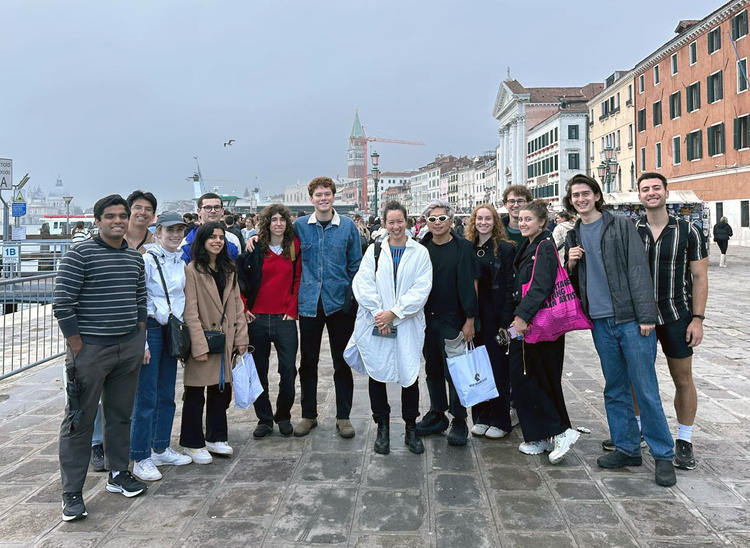
“This course had some of the best classroom conversations I’ve ever experienced at Princeton,” said Magnus von Ziegesar ’25 of ART 456 “Contemporary Art: The World Picture” on international mega-exhibitions of contemporary art as a form of worldmaking taught by Professor Irene Small. Over fall break, when the Venice Biennale became the classroom, the conversations expanded in kind. “Professor Small talks about how with art, each piece brings with it an excess of meaning—as if one could talk about a piece forever,” said von Ziegesar. “The way we all worked together in group discussion to tease out the context, references, maneuvers, formal qualities...etc. of pieces—how the piece would seem completely transformed after our discussion—was a (literally) eye-opening experience…it really was a situation where the discussion didn’t end—we just ran out of time.”
As the oldest and most influential perennial international art exhibition in the world, the Venice Biennale was central to ART 456’s investigation of global-scale exhibitions.
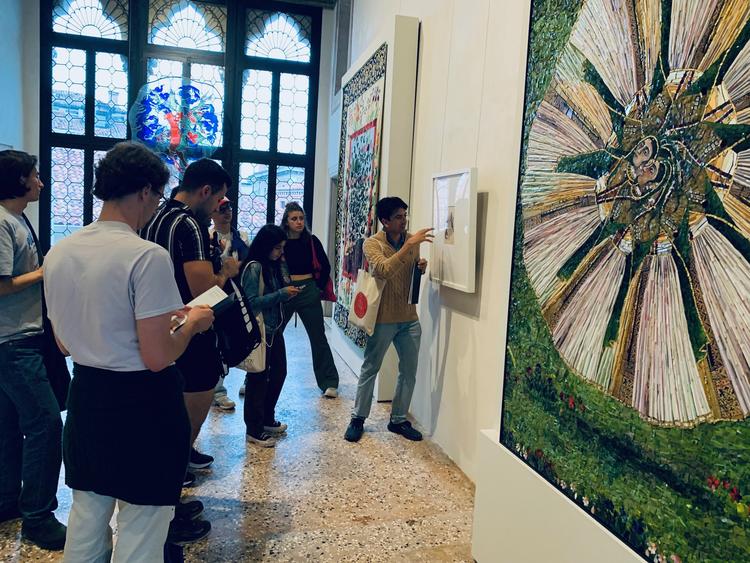 Students discussing the artist Shahzia Sikander’s work at her exhibition Collective Behavior at the Palazzo Soranzo van Axel (Photo courtesy of Irene Small and Paul Nadal)
Students discussing the artist Shahzia Sikander’s work at her exhibition Collective Behavior at the Palazzo Soranzo van Axel (Photo courtesy of Irene Small and Paul Nadal)
“Each week’s seminars have looked at historical biennials in an attempt to get a sense of the diversity and history of this defining structure of modern and contemporary art,” said A&A major Henry Moses ’25. “However, thinking through this history alongside the works presented in this year’s Biennale enhanced both my experience of the class and my experience of Venice.”
This year’s exhibition, titled Stranieri Ovunque - Foreigners Everywhere, was organized by Brazilian curator Adriano Pedrosa, the first Latin American curator to take on the role, and the first ever, as Pedrosa noted, to be living and working in the Global South (an appellation that refers to the regions of Africa, Asia, Latin America, the Middle East and the Caribbean). Small arranged a private meeting for the students with Pedrosa, who spoke candidly about behind-the-scenes processes of making a global exhibition of this scale. He also spoke of the significance of highlighting the work of indigenous and queer artists in this year’s exhibition, an emphasis that was in turn taken up in several of the independently organized national pavilions. “We had plenty of questions for him regarding the curation of particular rooms, the process for selecting artists, his timeline for an event of this scale, and his thoughts on the national pavilions,” said A&A major Robert Mohan ’26. “Although our entire experience in Venice had a ‘behind the scenes’ feel as a result of our thorough historical context, getting to talk to the biennale’s curator one-on-one really drove that feeling home,” he said.
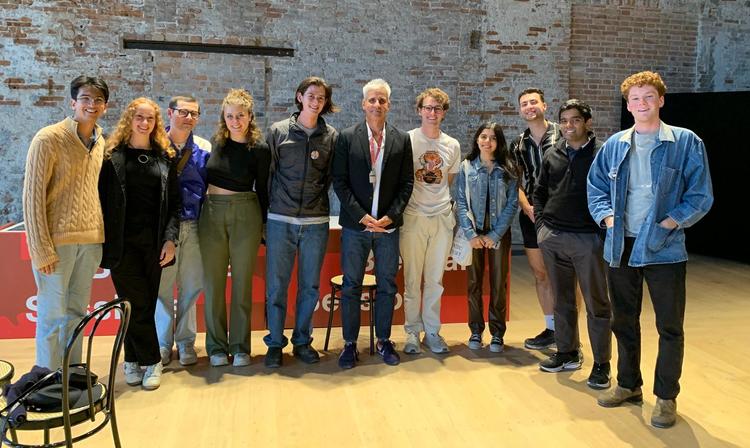 Students at private meeting with Adriano Pedrosa (center), Chief Curator of the 60th Venice Biennale and Artistic Director of the Museu de Arte de São Paulo (MASP) (Photo courtesy of Irene Small and Paul Nadal)
Students at private meeting with Adriano Pedrosa (center), Chief Curator of the 60th Venice Biennale and Artistic Director of the Museu de Arte de São Paulo (MASP) (Photo courtesy of Irene Small and Paul Nadal)
In addition to the main curated exhibition spaces of the Venice Biennale (the Giardini and Arsenale), the group visited several of these national exhibitions, as well as exhibitions housed throughout the city. The United States pavilion, for example, featured Jeffrey Gibson, the first Indigenous artist to represent the U.S. in Venice; and the Brazilian pavilion was collaboratively organized by a team of Indigenous curators and featured the work of Glicéria Tupinambá, an Indigenous artist who has been jailed for her activism against police violence. At Venice, her contribution concerned contemporary and historical Tupinambá mantles, which are feather capes used in shamanistic rituals, several 16th and 17th century examples of which remain in the collections of European museums.
The class was also joined by Paul Nadal, Assistant Professor in the Department of English, whose work considers intersections of literature and the economy, particularly as they pertain to global networks.
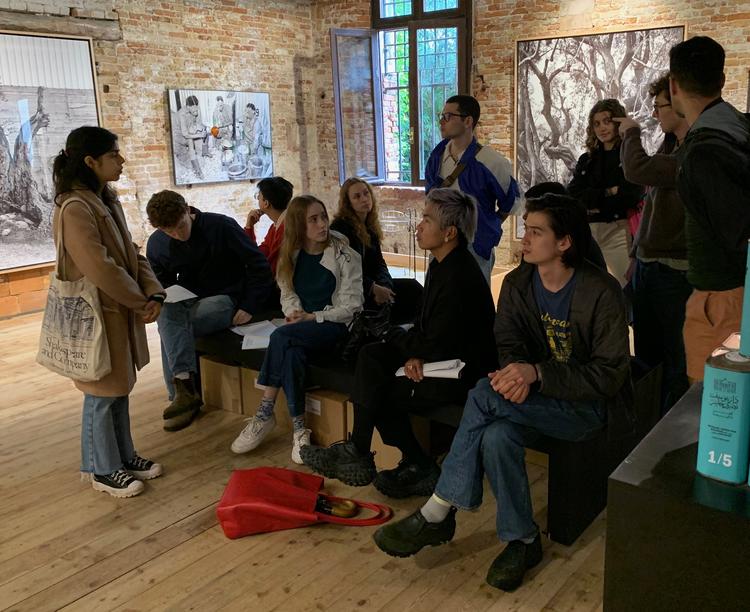 Students at South West Bank: Landwords, Collection Action and Sound, organized by Artists + Allies x Hebron in collaboration with Dar Jacir for Art and Research in Bethlehem (Palestine Pavilion) Palazzo Polignac, Magazzino Gallery (Photo courtesy of Irene Small and Paul Nadal)
Students at South West Bank: Landwords, Collection Action and Sound, organized by Artists + Allies x Hebron in collaboration with Dar Jacir for Art and Research in Bethlehem (Palestine Pavilion) Palazzo Polignac, Magazzino Gallery (Photo courtesy of Irene Small and Paul Nadal)
Small encouraged a collaborative approach to taking-in the exhibitions. “I usually prefer to walk through exhibitions solo, but Professor Small had us move through the exhibition with another student and discuss with the group afterwards, which led me to think about the works in ways I never would have on my own,” said comparative literature major Isadora Knutsen ’25. “I’ve learned so much from the class, and Professor Small. Getting to talk about art from morning to evening with everyone was a privilege.” Mohan agreed: “It was the most consecutive time I’ve ever spent looking at contemporary art, but the way we tackled the massive exhibition in small groups and solo walks really helped me process the art and its connection to the overarching theme.”
For von Ziegesar, highlights included the Nigerian Pavilion, the Palestinian Pavilion South West Bank, and the solo shows by the artists Pierre Huyghe and Shahzia Sikander. “The Sikander exhibition was especially noteworthy, as we studied her earlier in the semester, even dedicating parts of a class at Princeton to visit two of her works on campus,” he said. “I found the images in Peter Huyghe’s exhibition evocative and affective, which was interesting to me because I often experience AI-generated imagery as alienating and dystopic,” said Knutsen. “I also was really impressed by the installation which managed to modulate a kind of apocalyptic aesthetic across vastly different scales and forms.”
The students also visited the Jewish Ghetto, the Palazzo Ducale, and the Galleria dell’Accademia in order to consider the biennale’s theme of “foreigners everywhere” and the entanglement of art, politics, and global networks in a longer historical context. Said Knutsen, “exploring Venice as a site of ecological vulnerability, economic capital, and the birthplace of the term ghetto enabled us to apply our semester-long discussions about how the biennial format interacts with global networks of circulation and power directly.”
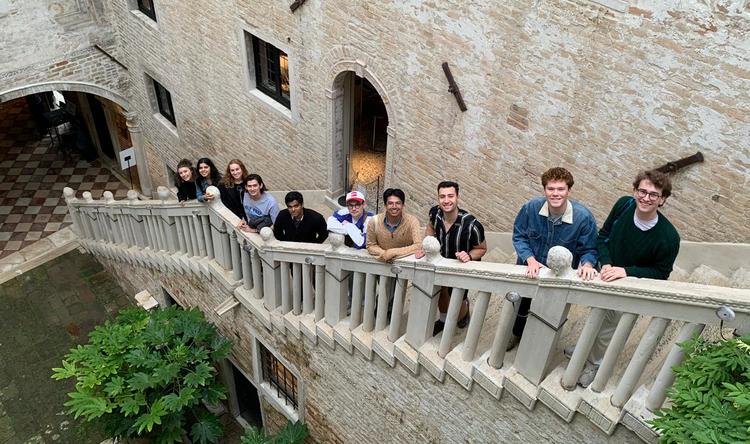 Palazzo Soranzo van Axel (Photo courtesy of Irene Small and Paul Nadal)
Palazzo Soranzo van Axel (Photo courtesy of Irene Small and Paul Nadal)
“It was incredibly moving to enter synagogues founded by Spanish and German communities in Venice, whose plain façades belied beautiful, ornate interiors,” said Small. “These interiors were commissioned by Jewish Venetians, who, we have to remember, were not allowed to join artistic guilds and practice craftsmanship themselves. To see the ostentation of art at the Doge’s Palace, and the historical enforcement of public austerity in the Ghetto, is to witness how visibility itself has been mobilized as a tool of power. How can we build on these lessons to think about belonging, citizenship, the production of exclusion, and the role of art today?”
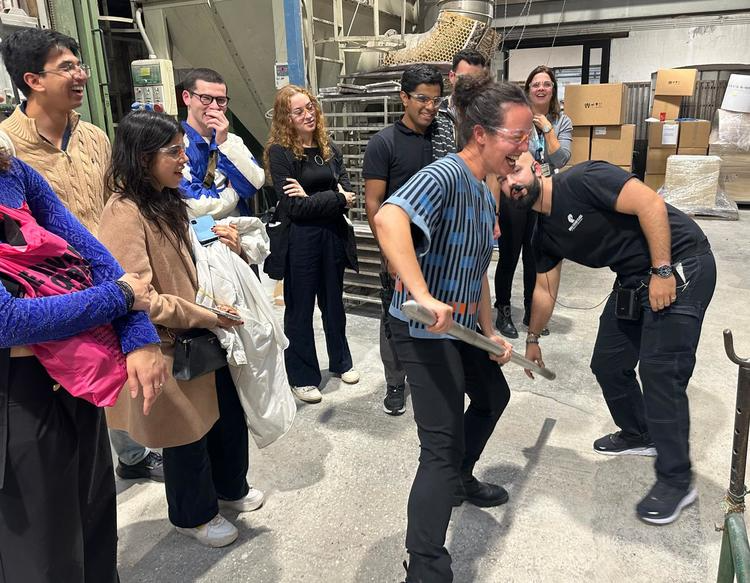 Professor Small trying out glassmaking equipment at Wave Murano Glass Furnace (Photo/Paul Nadal)
Professor Small trying out glassmaking equipment at Wave Murano Glass Furnace (Photo/Paul Nadal)
On the final day of the trip, the group visited the islands of Murano and Torcello, known respectively for glass production and 11th-century mosaics. Von Ziegesar appreciated Murano both for the chance to see art-in-the-making, and for its representation of a deep-rooted global artform through the trading of glass beads. Of Torcello, von Ziegesar commented, “It was fascinating to compare this spectacular, religious art, made anonymously thousands of years ago, to the art seen in a contemporary context—I think a helpful and refreshing comparison.” Small adds, “Torcello was the first island to be settled in the lagoon region, and lives in the Venetian imaginary as a place of refuge from the invasions of the North. What does it mean to conceive of Venice, not simply as a contemporary art-world destination, but as carrying within it this longer history of migrants, refugees, and cultural mixture.”
For Mohan, gazing up at the Cathedral of Santa Maria Assunta’s mosaic of the Last Judgement on the island of Torcello was a moment when “it all came together” for him. “Seeing all of the medieval mosaic’s painstaking portrayals of mortal souls being judged led Professor Small to note that select attributes of some subjects seemed to suggest ‘foreignness,’ he said. “As I looked closer to see what she meant, it was clear as day: some figures really were depicted with ‘foreign’ attire to represent a ‘non-believer’ category in the fateful moment of judgement. Something about that really struck me right then. It dawned upon me that our course’s theme wasn’t at all confined to Pedrosa’s concurrent biennale, but was instead an ongoing negotiation of ‘self’ and ‘other’ that, for an entire semester, we got to dedicate ourselves to critically examining.”
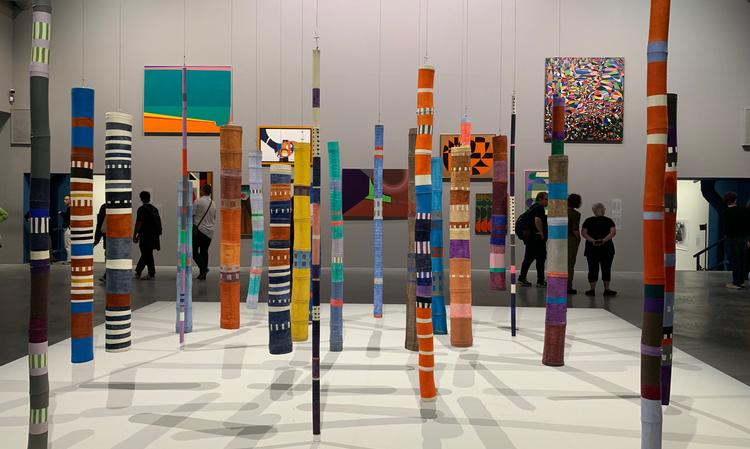 View of the Nucleo Storico: Abstraction gallery at the main pavilion of the 60th Venice Biennale Stranieri Ovunque - Foreigners Everywhere with installation by Ione Saldanha, Bambus (1969-1970) in foreground (Photo courtesy of Irene Small and Paul Nadal)
View of the Nucleo Storico: Abstraction gallery at the main pavilion of the 60th Venice Biennale Stranieri Ovunque - Foreigners Everywhere with installation by Ione Saldanha, Bambus (1969-1970) in foreground (Photo courtesy of Irene Small and Paul Nadal)
“Too often global contemporary art is equated with a market phenomena in which cultural difference or specificity is merely a sign for the circulation of cultural capital,” Small observes. “I want to use ART456 as a way to analyze this phenomenon, but also think seriously about the capacities of art to help us comprehend globality anew. In this sense, part of the aim of the course is also to encourage students to think critically about what it means to conceive, represent, articulate, and disseminate ‘a world picture’ from a situated and specific position within the world itself.”
By all accounts, Small’s aims were clearly achieved. “On one of the final afternoons, we were all given a little bit of free time,” recalls von Ziegsar. “I went to an exhibition showing the work of Julie Mehretu with a few classmates. We remarked that, after finally having a little free time to shop or even relax, we all just ended up looking at more art! I think this is a testament to how exciting and inspiring the trip was.”
“The aspect of the trip and the course which I’ve enjoyed the most has been our open-ended, participatory critiques of exhibitions and artworks,” said Mohan. “Our group is made up of twelve students from a wide range of departments, and the very language we use to get at abstract topics like ‘foreignness,’ ‘globalization,’ and ‘nationhood’ differs a lot from each other. It feels like we can pull at the same discursive thread in a work for practically hours at a time, arriving at new and exciting conclusions or launching-off points along the way. The group we had—our professors included—is what made the trip unforgettable, no doubt about it.”
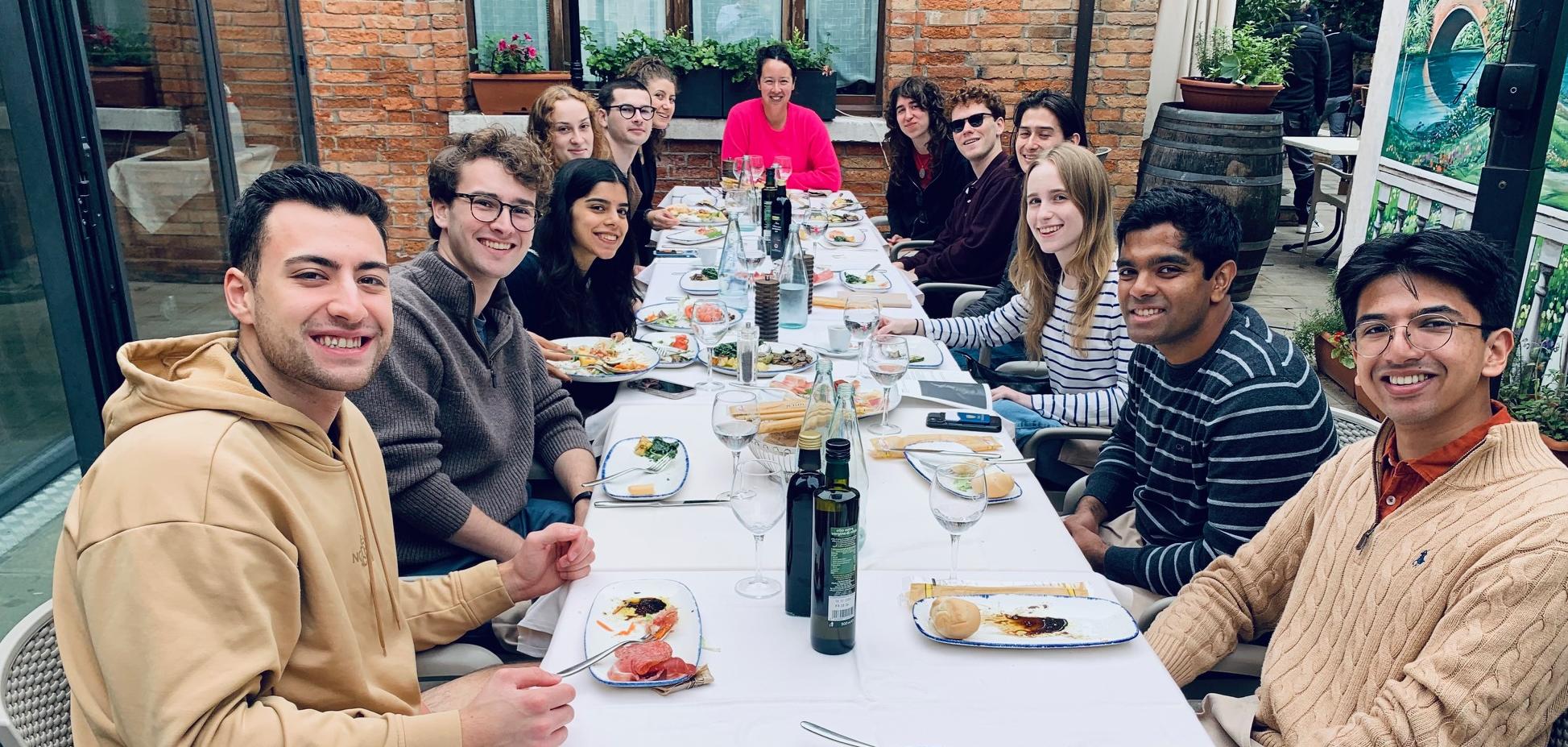 From left: Thomas Coulouras, John Slaughter, Jihan Khan, Sophie Main, Alex Picoult, Kate Stewart, Professor Irene Small, Isadora Knutsen, Henry Moses, Magnus von Ziegesar, Kate Weseley-Jones, Foyez Alauddin, and Robert Mohan (Photo/Paul Nadal)
From left: Thomas Coulouras, John Slaughter, Jihan Khan, Sophie Main, Alex Picoult, Kate Stewart, Professor Irene Small, Isadora Knutsen, Henry Moses, Magnus von Ziegesar, Kate Weseley-Jones, Foyez Alauddin, and Robert Mohan (Photo/Paul Nadal)
